by Winding Pathways | Apr 18, 2024 | (Sub)Urban Homesteading, Garden/Yard, Garden/Yard
Spring Ritual
After this weird winter, most of us in North America are simply ready for spring and want to get outside. Some folks take initiative and start garden and flower seeds indoors then transfer them outside when the weather moderates.
Are you ready to work the land? Try something new: No-till Gardening.
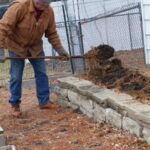
A rite of spring.
For generations, an April ritual all across the northern hemisphere is pulling the spading fork out of storage and firing up the rototiller. For generations, gardeners have learned from mentors, books, and videos that tilling is essential to create an abundant harvest of tomatoes, peas, beans, carrots, and so many other delicious garden vegetables.
Over decades and diligent research, we have learned that tilling is often just extra work that might harm the soil! Try no-till gardening.
Science Writer Shares Information
We recently heard science writer, author, and land steward Connie Mutel speak about how Iowa’s amazingly productive topsoil is being degraded by annual plowing and otherwise disturbing the soil. Mechanically mixing soil bares the soil to the air, where it oxygenates, leaching carbon into the atmosphere. When winds blow or rains fall, bare soil erodes. Waterways become contaminated and silt washes downstream eventually to the Mississippi Delta resulting in damage to commercial fisheries and wildlife there. According to Mutel, half of Iowa’s once 16-inch veneer of topsoil has been lost by tillage. For much more information check out her books available at the University of Iowa [email protected].
Reduce Runoff and Work
Most people aren’t farmers but many of us have backyard gardens. An annual activity is tilling. For years we followed conventional wisdom and used our trusty spading fork to turn over the soil each spring. Not so much anymore.
Last year encouraged by Drew Erickson, Farm Manager, of the Rodale Institute’s Midwest Organic Center, we left about half the garden untilled. “Tilling disrupts the organisms that make soil healthy and productive. “Try no-till gardening. Just plant your seeds in untilled soil,” he advised.
Last spring we tilled half the garden, smoothed out the soil, and planted our seeds.
We didn’t till the other half and just planted the seeds directly into the soil. A few months later we harvested at least as many vegetables from the no-tilled areas as the tilled……and we’d avoided the pitchfork work.
-
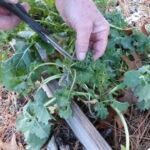
-
We planted kale directly into the ground with good results.
-

-
Summertime meal from the garden.
This year we’ll only till about a quarter of our garden. Into the rest we’ll plant our seeds and spread a layer of compost directly on the soil surface after the sprouts emerge.
We’re counting on bountiful harvests of many vegetables.
Join the Project
Give it a try. Put onion and potato sets, tomato plants, and bean seeds directly into the untilled garden soil. Let us know the results.
Learn More
Rodale Midwest is holding a free field day to show the value of minimum tillage and cover crops. It’s geared for farmers but gardeners are welcome. To register for the July 9, 2024, workshop go to the Rodale Institute Midwest Organic Center.
Have fun in the garden and enjoy a season of delicious vegetables.
by Winding Pathways | Apr 11, 2024 | (Sub)Urban Homesteading, Home Improvements
A rarely used handy tool made our lives easier after we found a box on our porch. It contained a remote weather station our two grown children chipped in to buy it for us.
Many parts needed to be assembled. That would have been difficult had we not been “tool proactive”. The weather station had a small door that covered a battery compartment. Opening it required using a tiny mini screwdriver.
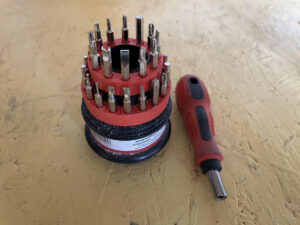
Screwdriver set with mini-bit-heads.
Rich occasionally buys somewhat unusual tools to help with special household or yard needs. One was a lifesaver for putting together the weather station. It was a mini screwdriver kit with about 20-bit heads made for jobs too small for normal tools. It helped us easily and quickly assemble the weather station.
How We Organize Tools at Winding Pathways
House Tools. Easy to Grab
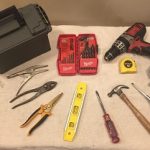
We find Milwaukee Tools, Stanley, and Vice Grips three excellent brands to have around.
We keep a toolbox in the house for quick needs. It includes Phillips and slot screwdrivers, pliers, Marion’s mother’s mini hammer, an adjustable wrench, measuring tape, a small “torpedo” level, a scraper, and a short coil of wire. The house toolbox is close at hand and enables us to fix most problems inside the house.
More Serious Diverse Tools.
Rich keeps major project tools on a pegboard in our cabin. These include hammers, squares, hand saws, many types of screwdrivers and pliers, files, chisels, hearing protectors, and clamps. On a nearby shelf is a toolbox holding rarely used tools. They’re specialty ones used when encountering unusual fixit or carpentry needs. These include odd drill bit sizes, unusually shaped files, contour gauges, and even a set of carving tools. Although not often used, once in a while they make life easy when a project has an odd need.
Battery Powered Power Tools
Although muscle-powered tools are perfect for small jobs, power tools make many projects shorter and easier. Rich keeps a drill, driver, jigsaw, circular saw, and sanders in a cabin cabinet. Over several years, battery-powered, or cordless, tools have come on the market. They are gradually replacing corded counterparts. Several companies make them, and each has its own battery system. It’s best to stay with one brand, so all tools operate on the same style battery. Rich began building his tool system with the Milwaukee brand years ago and occasionally buys a new power tool to add to the system. His Milwaukee batteries power carpentry tools as well as trimmers and chainsaws for outside use.
-
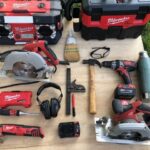
-
We switched to cordless tools gradually.
-
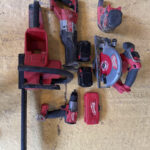
-
Stick with one brand of tools.
Tool Tips
- Buy quality tools. There’s a lot of junk on the market. Quality tools of any configuration are easier to use and last longer than cheap ones.
- Frequent garage sales. Years ago, most screwdrivers, wrenches, pliers, chisels, and clamps were high quality and made in the United States. These muscle-powered tools don’t go obsolete and often can be purchased for just a buck or two, even if they’re 40 or 50 years old. In contrast, many power tools sold at garage sales are equally old and inexpensive but often are much less effective than newer counterparts. Most are corded. They may be fine for occasional jobs but buying newer power tools is usually worth the money.
-
-

-
One way to measure a truck bed.
-
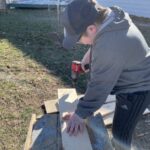
-
Learning to safely use tools.
Summary
Fixing and building items around the house can be a chore or a source of satisfying pride. Often, it’s impossible to find someone to hire for small fixit jobs, and hiring anyone to do a project is costly. Doing it yourself brings cost savings and satisfaction. Don’t know how? Check your friend, YouTube. Chances are good there are many posts showing how to fix or build it.
by Winding Pathways | Apr 4, 2024 | (Sub)Urban Homesteading, Garden/Yard, Pests
Easy Peasy Life for Ticks
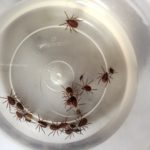
Collection of ticks
The recent warm winter was easy on heating bills and back muscles used to shovel snow, but it may mark an early return of Lyme Disease and the ticks that spread it.
At Winding Pathways we take a multi-pronged approach to reducing the odds of being bitten by an infected tick. Here’s great news! A new way to reduce Lyme Disease in white-footed mice is emerging which is good news for human health.
It was once believed that whitetail deer were the primary carriers of Lyme Disease with the theory that an infected tick leaves a deer and bites a human. Deer can carry Lyme Disease and pets and other wild animals can get it, but new research shows that white-footed (or deer) mice are the major carrier. Those tiny rodents are abundant where people live.
Old Standby Ways To Protect Against Lyme Disease
For many years we’ve done several things to lessen the chance that an infected tick will bite us.
First, we use repellents, even when working in the garden or enjoying a backyard barbeque. Deet-based repellents are widely available and repel ticks, mosquitoes, and even pesky flies. Deet can be applied to the skin. Permethrin is fatal to ticks and shouldn’t be applied to the skin. Spraying it on clothing makes life challenging for any tick seeking a human blood meal.
In recent years we’ve bought clothing from the Insect Shield Company. It is permeated with permethrin. Their clothing is stylish, comfortable, and durable, so we invested in several sets. In winter those clothes are stowed in the attic but worn daily during months when ticks are on the prowl.
Permethrin is sold in spray containers and it’s easy to treat jeans, shirts, socks, and shoes without needing to buy specially treated clothing. The chemical remains in clothing through several washings.
Second, we always do a tick check after being outside. Ticks typically walk around on a person for a few hours seeking a warm spot with thin skin to best extract blood. An unattached tick won’t spread disease, so after being outside we shed clothes, put them in the washing machine, take a warm sudsy shower, and check our bodies for ticks. They’re most likely to lurk in warm moist body parts but can be anywhere.
-
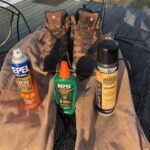
-
Pants, boots, varied sprays can reduce odds of picking up ticks
-
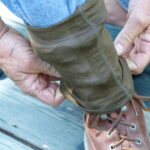
-
gaiters with tick guard helps repel ticks.
-
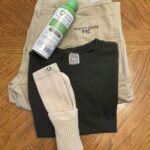
-
Pants, shirts, and socks infused with permethrin appear to keep ticks off.
New Promising Way to Reduce Lyme Disease
Relatively new research links the incidence of Lyme Disease with the presence of white-footed mice. Before we knew this we were already doing the right thing by encouraging mouse predators to live on our property. We love spotting hawks wheel overhead and hearing the chilling calls of nighttime owls. Both feast on mice. So do foxes, many snake species, and coyotes. Domestic cats also do but they kill many birds, so we are a catless family.
US Biologic is introducing a new way to reduce the odds a human will contract Lyme Disease from a tick that had bitten an infected mouse. They’ve been working on its development for 20 years, and it’s becoming available through pest control companies in many states.
Lyme Shield
It’s called the LymeShield System which combines traditional tick control with Lyme vaccine-coated pellets in a timed application dispenser. It doesn’t kill the mouse or any predator that might catch and eat it. A tick that bites an inoculated mouse will not pick up the Lyme bacteria. So, if that tick then bites a human it will not transfer the disease. The home page has a fascinating map that shows the progressive spread of Lyme disease.
US Biologic has come up with a clever way to help protect a family from Lyme Disease. We’re going to try it when it’s available in Iowa but we’ll keep using Deet and Pyrethrin and doing tick checks after being outside. We’ll also keep saying “thanks” to our predator neighbors that are constantly on the prowl for mice meals.
Being outdoors is amazingly good for human health. Playing ball, fishing, gardening, grilling, and even just sitting in a lawn chair offer healthy fresh air and sunshine. Fear of contracting Lyme Disease encouraged many people to stay indoors. Winding Pathways urges them to take tick precautions but spend as much time as possible outside.
Go outside and have fun.
by Winding Pathways | Mar 21, 2024 | Garden/Yard, Garden/Yard, Trees
Bright! Beautiful! Ominous!
As we walked across a New Jersey parking lot last summer an amazingly colorful, and new-to-us, insect fluttered in front of us. It had a gorgeous creamy white and bright red body covered with black spots.
Identifying it was easy and ominous. It was a Spotted Lanternfly. First found in Pennsylvania in 2014 it likely came to the United States from its native China as a hitchhiker in a crate or box.
It may be a pretty bug but its presence is ominous. It feeds on at least 172 different plant species and is spreading rapidly westward from its start close to the Atlantic Ocean.
Feeding off Another Invasive
What’s somewhat ironic about the lanternfly is the insect’s affinity for another Chinese invasive, the Tree of Heaven or Ailanthus. Although the inch-long insect will eat many different plants it prefers this highly aggressive and fast-growing tree.
Important Contact Information
The Iowa Department of Agriculture and Land Stewardship is on the lookout for the Spotted Lanternfly. They ask anyone spotting one in Iowa to report it by calling:
l (515)725-1470 or logging onto their website at IowaAgriculture.gov.
How To Reduce the Invasion
A key to reducing this insect’s abundance may be reducing Ailanthus tree numbers. This invasive tree thrives in urban and rural areas, often forming large groves. It displaces native trees, has little commercial value, and now harbors an introduced insect pest.
Winding Pathways encourages anyone with an Ailanthus in their yard to remove it, convert it to firewood if you can, and replace it with a native tree species. Remember, report any Spotted Lanternflies you spot.
-
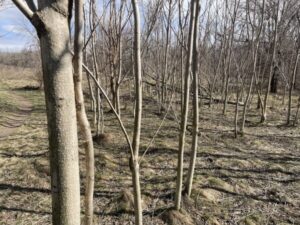
-
Grove of young Ailanthus.
-
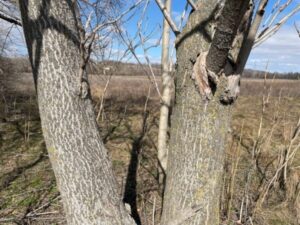
-
Ailanthus trees grow fast.
by Winding Pathways | Feb 29, 2024 | (Sub)Urban Homesteading, Home Improvements, Nature, Trees
Knot Just Lumber

A local store
When driving through Hiawatha, Iowa, recently, a nondescript sign caught our eye. Posted on what looked like a warehouse the sign said, KNOT JUST LUMBER. We had to check it out and soon entered the ultimate wood candy store.
Leaning upright were immense slabs of white and red oak, walnut, cherry, and mulberry destined to become gorgeous tables. Nearby were smaller boards of at least a dozen tree species. Most were cut from native Iowa trees, but some racks held exotic wood from foreign lands. Purpleheart caught our eyes. It comes from trees that grow in Central and South America. When first cut the wood is dull grayish but within a few days, it transforms into an eggplant purple color.
Local Connections
We returned to visit Nic Carter, who co-owns the store with his sister, Caris. The family is from Alburnett and Nic was an active 4-H member dabbling in woods making jewelry boxes for art shows. After stints as a woodworker and home builder Nic, and his family opened Knot Just Lumber in September 2022. He and his sister decided to open the store because, “The area has no local woodworking place, so, I started one here,” he explained.
His father and son help run this family-owned and operated business located just north of Cedar Rapids. We enjoyed an in-person tour, which is augmented by their website and includes a virtual walk-through.
Knot Just Lumber caters to hobbyists, commercial customers, and families. We have visited several times and enjoyed chatting with individual customers and couples, and watched kids touch and smell the smooth, fragrant wood. The company buys trees from wood brokers. Most originate from trees in southern Iowa. The company mills wood into various-sized boards and turning rounds, dries it in an onsite kiln, surface planes, and sands most boards.
Wood is Special
Wood is special. We’ve noticed that in many brand-new houses doors, window frames, and floors are crafted from composite materials and plastic.
Nothing seems natural. In contrast, our 1947-era house has floors of Douglas Fir and White Oak with our furniture crafted from solid oak, pine, walnut, and cedar. Different woods make our home feel closer to nature while gracing us with the individual vibrant colors, textures, and grain patterns of each species. The woods connect us to woodworkers, friends, and craftspeople from bygone and current eras.
Commercial Lumber
Commercial lumber is usually cut from the straightest and most uniform trees. Buy it from a large commercial outlet and it’s attractive and easy to work but lacks the character implanted in wood by knots and irregular growth. In contrast, every wood slab we saw at Knot Just Lumber showed the individuality and character of the tree that created it. “Some of the most interesting wood comes from trees that grew in urban areas where their branches spread widely. It helps give the wood wonderful character and beautiful grain,” said Nic.
Unfortunately, every year millions of trees, many growing in towns, are felled after they die. Beautiful wood inside the bark is frequently hauled to a landfill, ground into shavings, or cut for firewood. Knot Just Lumber converts old veteran trees into lumber destined to be crafted into furniture that endures for generations. The company even saves sawdust and compresses it into briquettes to feed a wood stove or campfire. We bought some and found that they work wonderfully. We appreciated Nic’s caution that they do burn hot, so we use them sparingly. We are excited to use them with our occasional campfires out back.
-
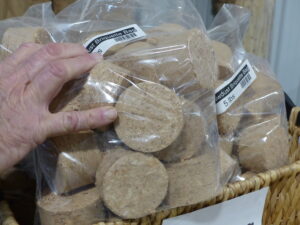
-
Value added and no waste.
-
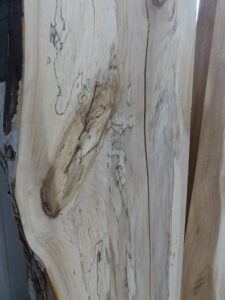
-
Fungi-laced wood
A Way to Add Character to a Room
The materials from our recent downstairs bathroom renovation are mostly manmade. That’s understandable, as the surfaces need to be easily cleaned and resist moisture. But the room needed the character of wood. So, we bought an oak board from Knot Just Lumber to cover a small area of plaster. It adds the warmth of nature to an otherwise utilitarian space.
Hidden Gems

Fusing old and new technology.
Knot Just Lumber is a local store we found by accident. The staff consult, have working spaces and classes for customers and specialize in epoxy with the wood to create gorgeous pieces for homes. Their prices are reasonable, especially compared to national stores or online sources. Similar local stores are scattered across the country. Finding them can be tricky but hobbyist woodworkers know where they are and anyone can Google hardwood lumber and they might learn of a nearby place to buy gorgeous local wood.
Resources
One of our favorite resources to learn the diverse characteristics of dozens of different species of native and exotic woods is the book WOOD! Identifying and Using Hundreds of Woods Worldwide, by Eric Meier.
-
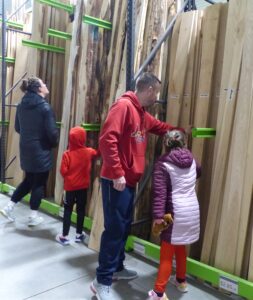
-
Families taking in the lumber.
-
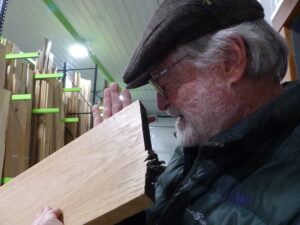
-
Assessing lumber.
-
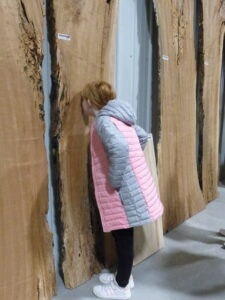
-
wood has a characteristic smell.
by Winding Pathways | Jan 18, 2024 | (Sub)Urban Homesteading, Birds, Nature, Pests
Frustration Yields to Creativity
Reprising the blog on thwarting House Sparrows. Here is a recap of our initial frustration and subsequent ways to encourage native birds and discourage exotics.
As we wrote earlier, hordes of House Sparrows almost made us give up feeding birds. We’d fill our feeders each morning and hope to watch juncos, cardinals, chickadees, woodpeckers, and nuthatches visit on cold winter days. Unfortunately, hordes of House Sparrows began arriving. We don’t mind feeding a few, but dozens soon devoured all the expensive seed, leaving empty feeders for native species.
Coming Up Short on “Expert Advice”
We asked bird experts what we might do to discourage House Sparrows and tried several of their ideas. Nothing worked well, so we experimented and came up with a few tricks that seem to discourage House Sparrows to a degree yet let other species eat. Our tricks aren’t perfect and sparrows still come, but not in huge numbers.
Here’s what we did:
Altered filling time:
We noticed that cardinals, jays, chickadees, and nuthatches visited feeders in the early morning and late afternoon, but House Sparrows came more late morning and toward the middle of the day. So, we put out small amounts of seeds early in the morning and again in late afternoon. Often our feeders are empty mid-day when the house sparrows prefer to visit.
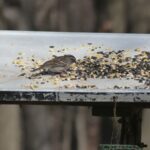
Eating from platform feeder
Sparrows enjoy feeding on the ground, on horizontal tables and other flat surfaces, and from silo-type feeders with long perches and large openings. We took down our standard silo feeders and replaced them with a silo shape feeder made of hardware cloth with a quarter-inch mesh.
In our quarter-inch mesh feeder, we put a mixture of black oil sunflower seeds and hulled peanuts. Native birds seemed better able to extract the sunflower from the mesh than House Sparrows. The peanuts don’t fit through the mesh, but many native bird species peck at them through the wire and extract pieces of peanuts. House Sparrows seem less able, or willing, to do this.
We also stopped feeding cracked corn and millet on the ground. Sparrows love them. Instead, we now toss full kernels of corn on the ground. Sparrows can’t swallow the big seeds and are unable to peck them apart. Woodpeckers, cardinals, blue jays, and nuthatches swallow or carry away the big seeds.
Put up with some House Sparrows
Our system helps deter these pesky exotic birds but is far from perfect. House Sparrows still visit and eat seeds but not as many as before we started using these tricks. Maybe they’ll work for you.
A few of you have shared. Now Others Can Share.
Winding Pathways is eager to learn other ways to deter House Sparrows. If you have discovered something that works, please let us know.
#























